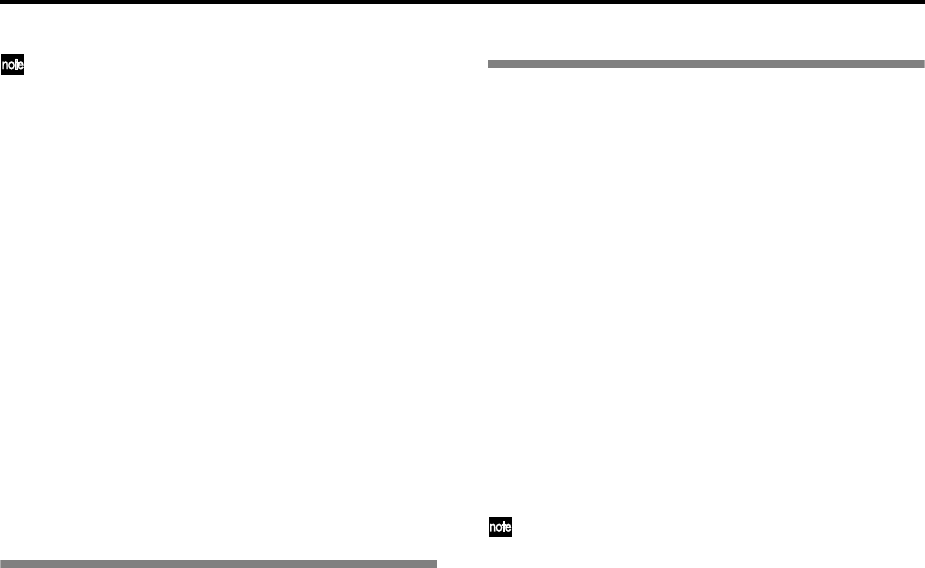
120
You can use the universal exclusive Coarse Tune
message to adjust the overall tuning that corre-
sponds to the Global P0: Basic Setup “Transpose”
parameter. (
☞p.120 “About system exclusive mes-
sages”)
Changing the pitch bend range
RPN pitch bend range [Bn, 64, 00, 65, 00]
This RPN message can be used to adjust the pitch bend
range for a program or timbre (in Combination mode)
or for a track (in Sequencer or Song Play modes).
The procedure is as follows.
1 [Bn, 65, 00, 64, 00]: Select RPN parameter 00.
2 [Bn, 06, mm, 26, vv]: Use data entry to set the value.
Normally only the upper byte is used.
A value of 0 [mm, vv=00, 00] is +00, and a value of
1536 [mm, vv=0C, 00] is +12 (one octave). Although it
is possible to set a negative value for a timbre/track,
only positive values can be set using RPN messages.
Controlling the arpeggiator (NPRN)
Arpeggiator operations can be controlled using NRPN
(Non Registered Parameter Number) messages. NRPN
messages can be freely used in non-compatible ways
by different manufacturers and models of instrument.
The procedure for using NRPN messages is the same
as for RPN, but you will use NRPN MSB (CC#99) [Bn,
63, mm] and NRPN LSB (CC#98) [Bn, 62, rr] messages
(n: channel, mm, rr: upper and lower bytes of the
parameter number) to specify the parameter.
NRPN arpeggiator on/off
[Bn, 63, 00, Bn, 62, 02, Bn, 06, mm]
This message will be transmitted when you press the
ARPEGGIATOR [ON/OFF] switch. When the switch is
turned ON the data will be mm=127 [7F], and when
turned OFF the data will be mm=0 [00], and the arpeg-
giator will be turned on/off accordingly. (This can also
be specified as a function of the ASSIGNABLE
SWITCH.)
Similarly, the arpeggiator will be turned on/off when
this message is received. (ON when mm is 64 [40] or
greater, and OFF when 63 [3F] or less.)
NRPN arpeggiator gate control
[Bn, 63, 00, Bn, 62, 0A, Bn, 06, mm]
This message will be transmitted when you operate the
ARPEGGIATOR [GATE] knob, and the arpeggiator
gate will change. When this message is received, the
result will be the same.
NRPN arpeggiator velocity control
[Bn, 63, 00, Bn, 62, 0B, Bn, 06, mm]
This message will be transmitted when you operate the
ARPEGGIATOR [VELOCITY] knob, and the arpeggia-
tor velocity will change. When this message is
received, the result will be the same.
About system exclusive messages
Since the way in which these messages are used is left
up to each manufacturer, they are mainly used to
transmit and receive sound data and editing data for
parameters that are unique to a particular instrument.
The TRITON’s system exclusive message format is [F0,
42, 3n, 50, ff, ..... F7]
F0: exclusive status
42: Korg ID
3d: [n=0–F] global MIDI channel 1–16
50: TRITON model ID
ff: function ID (type of message)
– ...
F7: end of exclusive
All models of the TRITON series use the same model
ID. Exclusive data can be exchanged between models
of the TRITON series.
To obtain a copy of the “MIDI Implementation”
which includes MIDI exclusive format informa-
tion, please contact your Korg distributor.
Universal system exclusive
Certain of the system exclusive messages are publicly
defined for a specific use, and these are called univer-
sal system exclusive messages.
The TRITON uses the following six universal system
exclusive messages.
Inquiry message request [F0, 7E, nn, 06, 01, F7]
Inquiry message [F0, 7E, nn, 06, 02, (nine bytes), F7]
When an inquiry message request is received, the TRI-
TON will respond by transmitting an inquiry message
that means “I am a Korg TRITON series instrument,
with system version ...”
GM system on [F0, 7E, nn, 09, 01, F7]
When this message is received in Song Play mode, the
TRITON will be initialized for GM playback.
Master volume [F0, 7F, nn, 04, 01, vv, mm, F7]
(vv: lower byte of the value, mm: upper byte of the
value, together indicating 16384 steps)
This message is transmitted if you assign Master Vol-
ume as the function of the ASSIGNABLE PEDAL or as
a B-mode function of a REALTIME CONTROLS [1]–[4]
knob and operate the controller. This will adjust the
overall volume balance without changing the relative
volume balance between timbres/tracks. When this
message is received, the result will be the same as
when the controller is operated.
Master balance [F0, 7F, nn, 04, 02, vv, mm, F7]
(vv: lower byte of the value, mm: upper byte of the
value, together indicating 16384 steps, where 8192 is
the default position, and lower values will move the
sound toward the left)
When this is received, the overall panning will be
adjusted without changing the relative panning
between timbres/tracks.


















